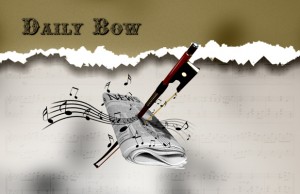 The survival of classical music performance as an art form has been, when you think about it, nothing short of anomalous. Despite the perceived slump in interest as the twenty-first century takes off, the performance scene has never been busier or better. In what other art form with largely 18th-century roots does the art survive almost unchanged? Visual art certainly isn’t still produced as a faithful replication of its Baroque- and Romantic-era antecedents, and neither does literature. In classical music audiences have a very real connection to a different time and a different place, and it is this unique and fascinatingly universal facet of classical music that has allowed it to endure and, like all other art forms, change, grow, and evolve to meet the artistic and aesthetic demands of modern society. It takes a resilient art form to handle the evolution from Beethoven to Xanakis and beyond and remain intact and unified, and that resilience is due in large part to the strong sense of tradition and community among musicians, be they teachers, performers, composers, or musicologists.
The survival of classical music performance as an art form has been, when you think about it, nothing short of anomalous. Despite the perceived slump in interest as the twenty-first century takes off, the performance scene has never been busier or better. In what other art form with largely 18th-century roots does the art survive almost unchanged? Visual art certainly isn’t still produced as a faithful replication of its Baroque- and Romantic-era antecedents, and neither does literature. In classical music audiences have a very real connection to a different time and a different place, and it is this unique and fascinatingly universal facet of classical music that has allowed it to endure and, like all other art forms, change, grow, and evolve to meet the artistic and aesthetic demands of modern society. It takes a resilient art form to handle the evolution from Beethoven to Xanakis and beyond and remain intact and unified, and that resilience is due in large part to the strong sense of tradition and community among musicians, be they teachers, performers, composers, or musicologists.
That sense of tradition has produced great benefits and an extraordinary sense of cohesivenss, but it it may also be responsible for a degree of stagnation in the field. Tradition, as it relates to teaching, has dominated the classical music scene for generations. Everyone knows who studied with whom, and, from this pedagogical lineage, it is often possible to determine to a substantial extent what a person’s teaching method will be like. But in an age in which we know more about the human brain, body, and body-mind relationship than we have ever known before–and in which we have a seemingly unlimited array of tools–tradition in teaching and performance is more and more giving way to innovation, investigation, and cross-disciplinary integration.
Music and science are mentioned more often in the same breath now than ever before, and the two fields’ mutual respect and admiration for what the other can do for it is growing. Toronto recently played host to a unique and exciting conference in which musicians, scientists, and educators met to discuss ways in which all of these fields can produce new ways of thinking and teaching. The two-day conference, called “Art, Science & The Brain: New Models of Learning for the 21st Century,” took place from October 31st to November 1st in Toronto’s MaRS Discovery District, at the University of Toronto campus. Featuring best-selling music-psychology author Daniel Levitan (This is Your Brain on Music; The World in Six Songs) and a slew of other eminent speakers, the event held forums on the physical space of learning, community partnerships between arts and science, and using technology effectively as a learning tool, among many, many others.
This event will hopefully spawn many like it around the globe as musicians, artists, scientists, teachers, and government officials get involved in the discussion of how we can best integrate all of the many resources in each field to better serve everyone. Read the full event listing on Toronto’s blogTO here.














No comments yet.